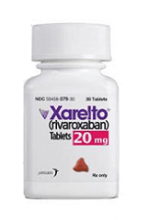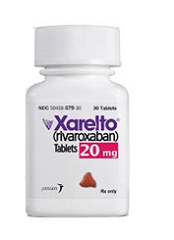User login
The US Food and Drug Administration (FDA) has approved use of a 10 mg once-daily dose of the factor Xa inhibitor rivaroxaban (XARELTO®).
This dose is now approved to reduce the risk of recurrent venous thromboembolism (VTE) in patients who have received at least 6 months of standard anticoagulant therapy.
With this approval, the rivaroxaban prescribing information provides instructions for physicians to begin treatment with rivaroxaban at 15 mg, dosed twice daily, for the first 21 days after a VTE occurrence.
On day 22 through at least day 180, the dose decreases to 20 mg once daily. After at least 180 days (6 months), physicians can prescribe 10 mg once daily in patients at continued risk for deep vein thrombosis and/or pulmonary embolism.
The FDA’s approval of a 10 mg once-daily dose of rivaroxaban follows a priority review designation from the FDA and is based on data from the EINSTEIN CHOICE study.
Results from EINSTEIN CHOICE were presented at the American College of Cardiology’s 66th Annual Scientific Session and published in NEJM in March.
Patients enrolled in this phase 3 study had confirmed VTE and were treated initially with standard anticoagulant therapy for 6 to 12 months.
During the study, 3365 patients received rivaroxaban at 10 mg, rivaroxaban at 20 mg, or aspirin at 100 mg once daily for up to 12 months of extended treatment.
Both rivaroxaban doses were superior to aspirin in preventing fatal or non-fatal recurrent VTE, the study’s primary efficacy endpoint.
The rate of recurrent VTE was 1.2% in the 10 mg rivaroxaban arm (hazard ratio [HR]=0.26; 95% CI, 0.14 to 0.47; P<0.001), 1.5% in the 20 mg rivaroxaban arm (HR=0.34; 95% CI, 0.20 to 0.59; P<0.001), and 4.4% in the aspirin arm. Fatal VTE occurred in 0%, 0.2%, and 0.2% of patients, respectively.
The primary safety endpoint was major bleeding as defined by the International Society on Thrombosis and Haemostasis.
The rate of major bleeding was 0.4% for the 10 mg rivaroxaban arm (HR=1.64; 95% CI, 0.39 to 6.84; P=0.50), 0.5% for the 20 mg rivaroxaban arm (HR=2.01; 95% CI, 0.50 to 8.04; P=0.32), and 0.3% for the aspirin arm. ![]()
The US Food and Drug Administration (FDA) has approved use of a 10 mg once-daily dose of the factor Xa inhibitor rivaroxaban (XARELTO®).
This dose is now approved to reduce the risk of recurrent venous thromboembolism (VTE) in patients who have received at least 6 months of standard anticoagulant therapy.
With this approval, the rivaroxaban prescribing information provides instructions for physicians to begin treatment with rivaroxaban at 15 mg, dosed twice daily, for the first 21 days after a VTE occurrence.
On day 22 through at least day 180, the dose decreases to 20 mg once daily. After at least 180 days (6 months), physicians can prescribe 10 mg once daily in patients at continued risk for deep vein thrombosis and/or pulmonary embolism.
The FDA’s approval of a 10 mg once-daily dose of rivaroxaban follows a priority review designation from the FDA and is based on data from the EINSTEIN CHOICE study.
Results from EINSTEIN CHOICE were presented at the American College of Cardiology’s 66th Annual Scientific Session and published in NEJM in March.
Patients enrolled in this phase 3 study had confirmed VTE and were treated initially with standard anticoagulant therapy for 6 to 12 months.
During the study, 3365 patients received rivaroxaban at 10 mg, rivaroxaban at 20 mg, or aspirin at 100 mg once daily for up to 12 months of extended treatment.
Both rivaroxaban doses were superior to aspirin in preventing fatal or non-fatal recurrent VTE, the study’s primary efficacy endpoint.
The rate of recurrent VTE was 1.2% in the 10 mg rivaroxaban arm (hazard ratio [HR]=0.26; 95% CI, 0.14 to 0.47; P<0.001), 1.5% in the 20 mg rivaroxaban arm (HR=0.34; 95% CI, 0.20 to 0.59; P<0.001), and 4.4% in the aspirin arm. Fatal VTE occurred in 0%, 0.2%, and 0.2% of patients, respectively.
The primary safety endpoint was major bleeding as defined by the International Society on Thrombosis and Haemostasis.
The rate of major bleeding was 0.4% for the 10 mg rivaroxaban arm (HR=1.64; 95% CI, 0.39 to 6.84; P=0.50), 0.5% for the 20 mg rivaroxaban arm (HR=2.01; 95% CI, 0.50 to 8.04; P=0.32), and 0.3% for the aspirin arm. ![]()
The US Food and Drug Administration (FDA) has approved use of a 10 mg once-daily dose of the factor Xa inhibitor rivaroxaban (XARELTO®).
This dose is now approved to reduce the risk of recurrent venous thromboembolism (VTE) in patients who have received at least 6 months of standard anticoagulant therapy.
With this approval, the rivaroxaban prescribing information provides instructions for physicians to begin treatment with rivaroxaban at 15 mg, dosed twice daily, for the first 21 days after a VTE occurrence.
On day 22 through at least day 180, the dose decreases to 20 mg once daily. After at least 180 days (6 months), physicians can prescribe 10 mg once daily in patients at continued risk for deep vein thrombosis and/or pulmonary embolism.
The FDA’s approval of a 10 mg once-daily dose of rivaroxaban follows a priority review designation from the FDA and is based on data from the EINSTEIN CHOICE study.
Results from EINSTEIN CHOICE were presented at the American College of Cardiology’s 66th Annual Scientific Session and published in NEJM in March.
Patients enrolled in this phase 3 study had confirmed VTE and were treated initially with standard anticoagulant therapy for 6 to 12 months.
During the study, 3365 patients received rivaroxaban at 10 mg, rivaroxaban at 20 mg, or aspirin at 100 mg once daily for up to 12 months of extended treatment.
Both rivaroxaban doses were superior to aspirin in preventing fatal or non-fatal recurrent VTE, the study’s primary efficacy endpoint.
The rate of recurrent VTE was 1.2% in the 10 mg rivaroxaban arm (hazard ratio [HR]=0.26; 95% CI, 0.14 to 0.47; P<0.001), 1.5% in the 20 mg rivaroxaban arm (HR=0.34; 95% CI, 0.20 to 0.59; P<0.001), and 4.4% in the aspirin arm. Fatal VTE occurred in 0%, 0.2%, and 0.2% of patients, respectively.
The primary safety endpoint was major bleeding as defined by the International Society on Thrombosis and Haemostasis.
The rate of major bleeding was 0.4% for the 10 mg rivaroxaban arm (HR=1.64; 95% CI, 0.39 to 6.84; P=0.50), 0.5% for the 20 mg rivaroxaban arm (HR=2.01; 95% CI, 0.50 to 8.04; P=0.32), and 0.3% for the aspirin arm. ![]()

